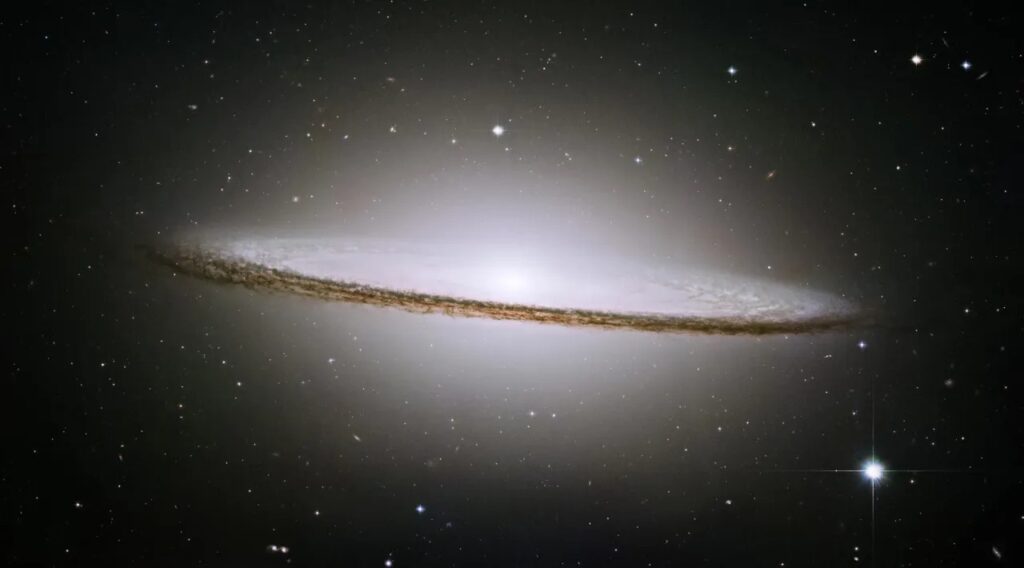The Sombrero Galaxy, also known as Messier 104 (M104) or NGC 4594, is a stunning example of a spiral galaxy located in the constellation Virgo. It was discovered by Pierre Méchain in 1781 and later added to Charles Messier’s catalog the same year. The galaxy’s distinctive appearance earned it the name “Sombrero” due to its striking resemblance to the broad-brimmed Mexican hat when viewed edge-on from Earth. This nickname stems from its prominent dust lane encircling its bright central bulge, which gives it a disk-like appearance with a dark hat-like rim.
Physical Features
M104 is located approximately 28 million light-years away from Earth and spans about 50,000 light-years in diameter. It is classified as a lenticular galaxy, though it exhibits some characteristics of both spiral and elliptical galaxies. The galaxy’s central bulge is densely populated with older stars, giving it a yellowish hue, while its extended disk contains a mix of older and younger stars, along with dust and gas clouds.
One of the most striking features of the Sombrero Galaxy is its prominent dust lane that obscures part of its central bulge. This lane is thought to be the remnants of a smaller galaxy or a molecular cloud that was absorbed during an ancient merger event. The interaction and subsequent gravitational effects have shaped M104’s current appearance, contributing to its unique structure and observed characteristics.
Black Hole
The Sombrero Galaxy is known to harbor a supermassive black hole at its center, commonly referred to as the galactic nucleus. This black hole is believed to have a mass equivalent to about 1 billion times that of our Sun, making it one of the largest known black holes in nearby galaxies.
The presence of this supermassive black hole is inferred from the motions of stars and gas near the galaxy’s center. These stars and gas clouds orbit around the center of the galaxy at speeds that suggest the gravitational influence of a massive, compact object—indicative of a supermassive black hole. Additionally, observations of powerful radio emission and X-ray emission from the nucleus further support the existence of this central black hole.
Despite its massive size, the supermassive black hole in M104 is relatively quiescent, meaning it is not actively accreting large amounts of material or producing strong emissions compared to some other galaxies with active galactic nuclei (AGN). This quiescent state suggests that the black hole’s accretion rate is currently low, although past interactions and mergers with smaller galaxies may have triggered more intense activity in the past.
Studying the supermassive black hole at the center of the Sombrero Galaxy provides valuable insights into the formation and evolution of galaxies. It helps astronomers understand the relationship between galaxies and their central black holes, as well as the processes that govern black hole growth and activity over cosmic timescales.
Globular Clusters
M104 is estimated to have a relatively small population of globular clusters compared to other large galaxies like the Milky Way or Andromeda. Observations suggest that it may have around 1,200 to 2,000 globular clusters in total. These clusters are distributed throughout the galaxy’s halo and are thought to have formed during the early stages of M104’s formation, over 10 billion years ago.
Studying M104’s globular clusters allows astronomers to investigate various aspects of the galaxy’s history. The ages, chemical compositions, and spatial distribution of these clusters provide clues about the conditions in the early universe and the processes that shaped the Sombrero Galaxy over billions of years. For example, the properties of globular clusters can help determine the age of the galaxy’s stellar population and shed light on its formation timeline.
Virgo Cluster
The Sombrero Galaxy is a prominent member of the Virgo Cluster, a large collection of galaxies located about 60 million light-years away from Earth. Its membership in this cluster places it within a dynamic environment where interactions between galaxies are common, influencing their shapes, star formation rates, and overall evolution.
Observation
M104 is relatively bright, with an apparent visual magnitude of around 8.0. This makes it visible through small to moderate-sized telescopes and binoculars under dark skies, though its distinctive dust lane and central bulge are best appreciated with larger telescopes. Astrophotographers also find the Sombrero Galaxy an appealing target due to its unique appearance and the opportunity to capture its intricate structure and details in long-exposure images.

The Sombrero Galaxy can be observed during the spring months in the Northern Hemisphere (or autumn in the Southern Hemisphere), specifically from March to May. In March, it begins to rise in the late evening and is visible throughout the night as it moves across the sky. April offers excellent viewing opportunities, as it reaches its highest point in the sky during the late evening and remains well-positioned for observation into the early morning hours. In May, it is still well-placed for observation, although it starts to set earlier in the night as the month progresses.



